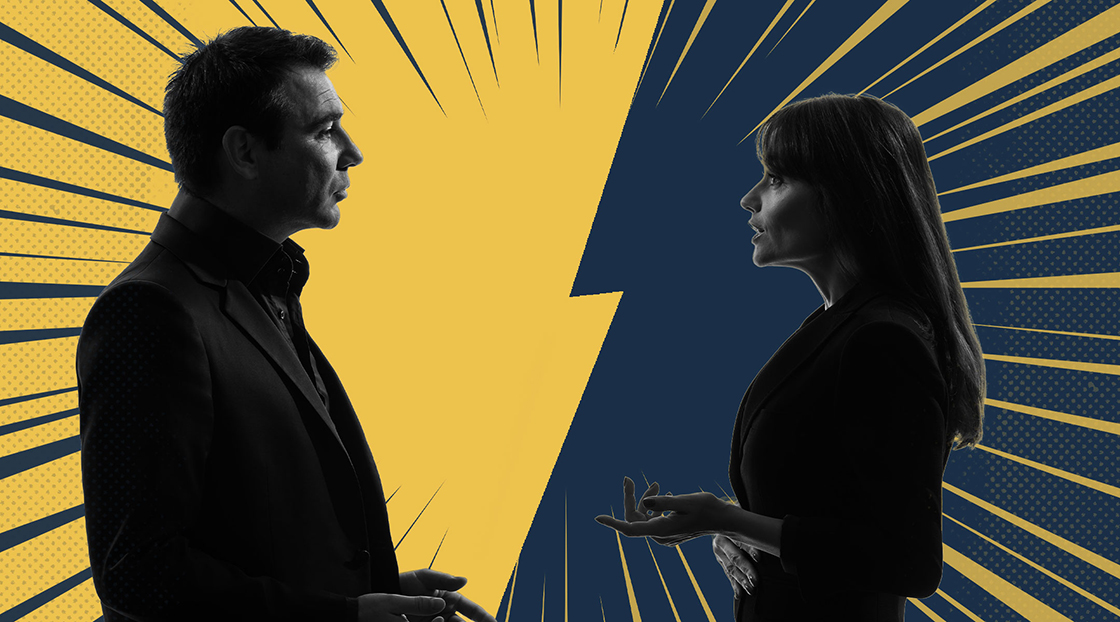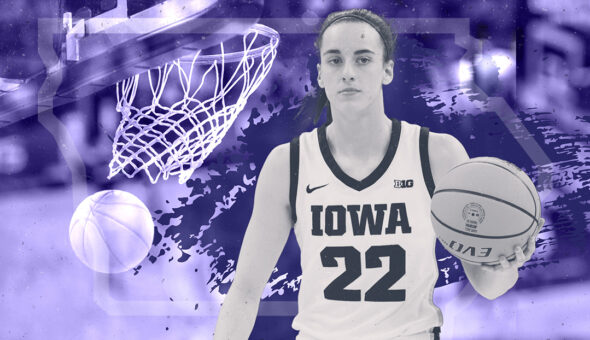Marketing and communications are different professions, so why do the roles of chief communications officer (CCO) and chief marketing officer (CMO) often get conflated in higher education. On the latest Higher Voltage, Teresa Valerio Parrot and Erin Hennessy of TVP Communications join host Kevin Tyler to discuss why that’s problematic, what the definitions, duties, and success metrics should be for each position—and the ideal structure of marcom functions at colleges and universities.
- 2:30: The definitions of, and differences between, a CCO and a CMO.
- 6:05: Why and how these two roles often get conflated in higher education.
- 11:10: The different metrics that gauge success for CCOs and CMOs.
- 14:30: How the structure between communications and marketing has shifted, and who should be the lead storyteller for higher ed institutions.
- 20:35: How to communicate to audiences ways that are truly inclusive, and not performative.
- 23:40: The increasing sophistication of higher ed marcom.
- 29:20: The ideal structure and placement of marketing and communications functions within higher ed.
Complete transcript
Kevin Tyler:
Higher Voltage is brought to you by Salesforce. Today’s higher ed marketers face new challenges, and must expand beyond traditional tactics to engage their many audiences. Learn how Salesforce empowers institutions of all sizes to unify first party data, build and measure targeted campaigns, and deliver personalized messaging across channels. Visit salesforce.org to learn about how Salesforce can help your college or university achieve its goals.
Hello and welcome to Higher Voltage, a podcast about higher education that explores what’s working, what’s not, and what needs to change in higher ed marketing and administration. I’m your host, Kevin Tyler.
Welcome back to Higher Voltage with two of my favorite humans, Teresa Valerio Parrot and Erin Hennessy, both of TVP Communications. On today’s episode we will be chatting about the differences between a CMO, Chief Marketing Officer, and a CCO, Chief Communications Officer. And some of the things that we see on college campuses across the country. And how those roles have become like catch-all buckets on some campuses. And what the argument is for splitting those two roles up. And being more thoughtful in the ways that marketing and communications aren’t the same role. They’re very different roles. Teresa and Erin, thanks so much for coming back to Higher Voltage.
Teresa Valerio Parrot:
Thank you for having us. It’s always a pleasure, and also, I always love having a conversation with two of my favorite humans as well.
Kevin Tyler:
Oh my gosh, this is going to be a love fest. Before we dig into the conversation, just for folks who may not have listened to the initial episode that you were on, could you just give a super brief introduction so people know who you are, and what you do, and where you are from? Teresa, we’ll start with you.
Teresa Valerio Parrot:
Okay, perfect. I’m Teresa Valerio Parrot, and I’m Principal of TVP Communications. We work with college leaders at the intersection of leadership and communication. And we were most recently on talking about how impossible presidential and senior leadership jobs are in college campuses these days.
Kevin Tyler:
Right on. Erin?
Erin Hennessy:
Sure. My name is Erin Hennessy. I’m Executive Vice President at TVP Communications. I have been here, amazingly, for almost nine years, and previously worked at the American Council on Education. Started my career on a campus, and you are also one of my favorite people, Kevin, as is Teresa.
Kevin Tyler:
Oh my word.
Erin Hennessy:
But she knows that, because I tell her all the time.
Kevin Tyler:
I tell her too. Okay. This is a super interesting topic to me, especially now in my new role at my agency as Director of Community Engagement. Working with CMOs from across the country and providing opportunities, experiences, and insights that help them, not just with their day-to-day job duties, but also preparing them for whatever is next in their professional lives.
And my first question comes from some of the titles that I’ve seen from the folks I’m working with closely. I have seen Vice President of Brand. I have seen Associate Vice President of Communication, PR, and Digital Strategy. I have seen so many variations of this title that it’s become almost an entity in and of itself. And so, I’m curious from your perspectives, what are the differences, foundationally, between a CCO, Chief Communications Officer, and a CMO, Chief Marketing Officer, and how you define those roles?
Erin Hennessy:
I’ll jump in real quick, and I know Teresa has some thoughts on this as well. But for me, most foundationally, it comes down to audience. And in my mind, the Chief Marketing Officer is dealing almost exclusively with an external audience, where your chief communications officer is thinking externally about alumni, and parents, and prospective students, but we’re also spending a lot of time thinking about those internal audiences.
I would argue, and I don’t think, Teresa, you’d disagree, that those internal audiences are in many ways more important than the external. That’s sort of how I started to break down the differences between those two titles. I think a lot of times we see marketing titles that attempt to mirror or mimic what is going on in the agency world of marketing and I think part of that is to reflect how the tools and channels that we have to reach audiences are evolving. But I also think part of it is to attempt to attract really good, really talented people to our campuses, to these marketing roles where the agency side might be a little more lucrative, or a little sexier. I think it’s driven by some of that talent recruitment and talent management, those kinds of priorities. But Teresa, do you think I’m way off base here, or are we in alignment on this one?
Teresa Valerio Parrot:
Erin, I’m so glad that you started by talking about audiences, because on the piece of paper next to me, as Kevin was queuing up his question, I wrote down “audiences”. And I think that’s what connects us. The two different positions that we’re increasingly seeing as a catchall for a whole bunch of different communications and word-based outputs. And I think there are very different ways in which each of us goes about our jobs.
From a communications standpoint, we are tasked with thinking about relationships, and that’s rooted in authenticity and truth. And when we don’t lead with those two, it harms our relationships. And on the marketing side, the focus for those positions really is more on image and reputation, and you’re allowed to have some aspirational elements to how you talk about an institution. And that’s so different, again, than the communication side of this. So, as we think about marcomm being the mashup of marketing and communications, I genuinely believe that the strongest connection between marketing and communications these days is an ampersand, rather than what the expectations are for each of us in those positions.
Kevin Tyler:
I think that’s an excellent way to describe what we are talking about today. I’m very curious about how the two roles seem to have been conflated into the same thing, and that require very different skill sets. I don’t understand why it’s like that. I don’t know if it’s efficiency? Why do you think these two roles have been conflated the way they have, in higher ed especially?
Teresa Valerio Parrot:
I think there’s always been a jockeying between the two, and I think in part it’s based on how we think about image and reputation. Obviously on the comm side, those are metrics that you’re looking at, but you’re looking internally and externally for a whole bunch of other elements as well. And I think that as time has gone by, in some ways I think our marketing colleagues have been excellent marketers at talking about what this pool can be. So that you have both financial and human resources, and there is enough that’s similar about us that it seems that we should go together.
And I also would say, I think one of the pressure points is, who gets that seat at the table with the cabinet? Is it marketing? Is it communications? And for us, I think it’s a really interesting litmus test, when we look at a cabinet, to see which of those titles is at the table? It gives us a great sense of where the president is, and perhaps how that cabinet is thinking as well.
Erin Hennessy:
I also would be really interested, and I don’t know who would have this data, in looking at the rise of the Chief Marketing Officer, and just the rise in marketing in general. My personal experience is on a smaller, but large campus. I worked in enrollment management there, at the very beginning of my career. And then later worked in central administration in the president’s office. And at that point we didn’t have marketing. Marketing was what enrollment management did. Sure, we had full page ads for speaking programs, and we did radio spots for our large presidential speaker series, but we didn’t have a marketing operation.
And so, I’d be fascinated to see when that sort of started. I’m guessing it would be earlier at larger institutions, public institutions that have athletic programs. But I think the more recent rise of that entire function left leaders with the question of where do we put this? And I think in a lot of places, you see that marketing function live under enrollment management. Sometimes we’re all lumped together between enrollment management, alumni development and marketing, and comms in a institutional advancement function. I don’t know, I like to think on some level folks look at comms and marketing and believe we’re practicing some kind of dark magic somewhere, and they sort of figure they’d put us all together.
But I do think that comms and marketing, as Teresa said, very different functions. Very different audiences, very different tools. And I’m not afraid to put my communicator’s bias out there and say I would far rather see a communicator at the table, in terms of cabinet, simply because the reputational challenges that we’re dealing with, I think, fall more squarely in the communication’s responsibility. I wouldn’t be opposed to seeing both a Chief Marketing Officer and a Chief Communications Officer, because I think they are such different functions, serving different audiences. But I’m guessing in a lot of places you see Chief Marketing Officer, or marketing first and communications second. Because of the enrollment demands and the budget demands that so many institutions are facing, that’s where their priority is and that’s the person at the table.
Teresa Valerio Parrot:
If I think back to my early days as consultant, so that was about 17 years ago, and it was after the Tom Hayeses and the Larry Lauers of the world had launched this idea of marketing in higher ed. And you had the Christopher Simpsons and Elizabeth Scarboroughs really latching on to that. Having worked directly with Christopher, the way that he always talked about it is, “Let’s go ahead and have comms, have marketing fall under us because with marketing comes budget, with budget comes power.” So I really think that he saw it as communications and marketing. But again, I think that the battle between the two of those really shifted and that marcomm term really took off in much different ways.
But I would say to Erin’s point, the conversations at that point were, “What are the pressure points that higher education is feeling?” And it really was around enrollment, and it was making sure that you were competing in that mimicry, as well as that idealization way, with those who are ranked above you. There really was a different feel for how it was that we were talking about higher education, even 17 years ago, that allowed for this space. Then with additional dependence on enrollment management dollars, I think it’s shifted that much more.
Kevin Tyler:
So I have a couple of questions, just in reference to the responses that you just gave. Erin, to yours, I am also struck by the different kinds of ways to measure CCO tasks and CMO tasks. And I am not a communicator, but to me it seems like CCO department things are much more concrete metrics that are numbered. We have this many eyeballs on it, this many clicks, this many whatever. Whereas marketing metrics are a little bit more squishy, right? It’s around awareness and perception and these ethereal kinds of words. At least, that’s the space that I work in, and I’m just kind of curious. I know how my brain works and I know that I am not a communications brain thinker. I’m more of the squishy kind of thing. Can people be both right brain and left brain in the way that it feels like CCO and CMO are?
Erin Hennessy:
Can this marriage be saved, Kevin? It’s so funny you’d say that, because from where I sit, it’s exactly the opposite. You marketers have all the analytics and the conversions, and the open rates, and the click throughs. You guys have reams of data, and what we tend to have is some really, I mean, squishy is the nice way to put it. Some really garbage data that sort of guesstimates how many eyeballs might see that thing, in that place, in that one publication while it’s there.
We have open rates, we have click throughs, things like that. But I think, in my mind, you guys have treasure troves of data and we’re over here trying to, to your point, talk about image and reputation in ways that are really hard to measure. Again, I think this might be why folks that don’t live in our marketing and communications world sort of smoosh us together, because we are together. The two fields are still struggling to figure out how to best make the case for our work and to show that we’re doing what we say we’re doing. Because, particularly with comms, it’s really hard to prove the counterfactual. I’ve kept you out of this reputational issue, I’ve prevented this crisis from spiraling. It’s really hard to prove, sometimes, that our work is having the impact that we have told you upfront, when we asked for the resources, that it will have. So, I come from the other side of the coin than you do.
Teresa Valerio Parrot:
And I think part of that, Erin, is that communications naturally, public relations falls under it. So people look at the metrics that are associated with public relations and know we’re still trying to catch up to those, because we used to be able to talk about the value-per-column inch. Now, think about that. We’re really shifting how we’re talking about things. But as a result, people still want to keep communications metrics in that public relations sphere, and we’re so much more than that. I think we need to do a better job identifying and also marketing how it is that we talk about what we’re doing and our impact.
And I can say, we’re having this conversation within TVP Comms. I’m right now having this conversation with Executive Vice President Terry Flannery at CASE. And I think all of us are looking to figure out how metrics can help the marketing and the communications side better advocate for that position at the table with cabinet, but also the resources and the people to help us do all of what is expected of us, because it continues to grow.
Kevin Tyler:
Thinking about some of the issues that higher ed has in front of it, as an industry, how has the structure between communications and marketing needs kind of shifted, if at all? In the time that we’re in now, do you think that it will be the marketers that get us closer to where we need to be? Obviously there’s far other responsibilities and tasks and duties that will need to be done and fulfilled, but from the storytelling, the reputation, from all of that, is it the marketers or is it the communicators?
Teresa Valerio Parrot:
I would’ve a much different answer for you in February 2020 than I have today. I think in February 2020, I would have said the marketers are outpacing us communicators in helping people understand what they do and the need for their roles. But when COVID hit, what we definitely found, and we partnered with a number of chief marketing officers, is that they recognize that the skillsets that they needed at that time for their institution were on the communication side. It was the internal communication skillsets, it was making sure that how we think of audiences was how they were framing messages. Again, it goes back to authenticity and truth and trust. So, there was a moment where that shifted so significantly and communications rose to a necessity.
And I will be curious to see, now that we’re in theory coming to the next stage – I don’t know that we’re done with the pandemic – but the next stage, that this is a time that really each of us is going to have to figure out what that right mix is, because the conversation has shifted so significantly.
Kevin Tyler:
I love the point that you make around audiences, and I feel like the question that I’m thinking of now is about shifting the efforts that are typically considered to be external audience communications and marketing inwards, because of all the things that are going on in higher ed and how that might shift responsibilities at leadership levels, especially in communications and/or marketing. And with NACAC and student retention, faculty and staff, where are they in this whole conversation around internal/external marketing and communications? I’m just curious about your thoughts on what that might look like, now that we have such a bifurcated approach. That’s the only word I can come up with at this moment about all the responsibilities that communicators and marketers have on a campus.
Erin Hennessy:
You know, I started this conversation with a comment about internal audiences versus external audiences, and I think we’re at this moment, as Teresa pointed out, this conversation would have been very different in February 2020. But in August 2022, I think the smart institution is refocusing its marketing and communications efforts to be both internal and external. When we look at how very fluid our students relationships are with our institutions now. That lost COVID generation of students who maybe kept going, started their college experience online, went through freshman and sophomore year online, they don’t have a particularly strong connection to us. So whether or not they complete the degree with us, we hope they do, but I would be doing some marketing to them to try and keep them. I would be rolling that marketing perspective into a retention conversation.
If we look at our faculty staff and see the great recession, the quiet quitting… I’ve been following, because I’m an alumna, the staff strike at American University this week as students are moving in to campus. As we look at a real realignment of faculty and staff relationships with their institutions as well, I would be looking at how we “market” to the people that we’ve already hired. It’s one of the biggest cliches in higher ed, but it’s much, much less expensive and much less work to keep the fill-in-the-blank, students, faculty, staff, you already have rather than to go out and find new ones.
I’m hopeful that the communications and marketing teams can work together to look at those internal audiences somewhat differently. Then thinking about young alumni who have come through the pandemic and have graduated from our institutions, again without feeling necessarily a really deep and foundational connection to our colleges and universities, looking at how we market to and target those audiences somewhat differently than we would have in the past.
Teresa Valerio Parrot:
On a similar train, I was talking to a cabinet yesterday, a president and all of their vice presidents, and I was talking through the fact that higher education has become so much more transactional. We used to be so relational, now we’re transactional. If you tie that from my geeky, organizational theory perspective, it really is tied to the economics of the industry. But we’ve allowed the economics of the industry to impact how we reach out and connect with others. I think this is a pivotal time for us really to be thinking through, how do we get back to how we want to have relationships exist and move away from transactional? Especially with those students that haven’t had that connection with us. I think more fundamentally we need to be asking ourselves with everything we send and every way that we think about our communications, we need to think it through the perspective of those audiences and ask ourselves, “How will they view how this impacts them?”
I think that’s critically important. Erin and I are known for working with campuses and sending out communications, and we’ll have a core message but we’ll send 13 different versions of that same message out to each, individual audience so they see themselves reflected in that language. And that’s important. It takes time, but if we’re talking about relationships, relationships take time. The more we put this into the bucket of expediency and our own time frames, that’s when we move to transactional.
Kevin Tyler:
Hey, you are preaching to a choir right now, to me. That’s exactly right. I understand the lift that it can sometime be for segmentation to be successful, for segmentation to even start on a college campus. But the importance of that is so critical to the people who are receiving it, and I think that is part of the obstacle in higher ed marketing and communications. That we are creating things from what we think is the right thing and not really thinking about what the audience is expecting, what they need, uses language that folks might not be used to. How do we still get a message to its intended audience without making them invisible? Without making the person who’s receiving it invisible, unimportant, looked over, and instead include them in this piece in a way that feels real, not performative, and as compelling as it can be in a segmented approach? I think that’s absolutely right.
Teresa Valerio Parrot:
We’re moving you over to a communicator, Kevin. We’re talking about authenticity and truth, and here you are saying it too.
Kevin Tyler:
I believe in both those things. What were you going to say, Erin?
Erin Hennessy:
What I was going to say is that I think at this point, it goes beyond best practice and it goes to what is the base level expectation of all of our audiences? Our audiences are so much more savvy about how they are being communicated to. The messages that they’re receiving; how segmented they are; how much thought has been put into who I am. What I’m looking for from this relationship or this transaction, depending on what footing I’m on with this organization. I think the institution that doesn’t give their audience credit for being smart about communications and marketing is the institution that misses that opportunity to move from transactional to relationship.
We’re basically giving you our entire presentation at this point, Kevin. But one of the things we talk about frequently when we’re meeting with presidents and cabinet is talking about pitching messages that don’t presume deep expertise on the part of your audience, but also don’t assume that they’re starting from zero. Giving your audiences credit, believing that they are engaged and smart and savvy, before you sit down and start putting those messages together is really important. In this day and age it’s a baseline expectation.
Kevin Tyler:
Totally baseline. And I would add that not only are many of the audiences more savvy, there are also lots of new, other places to either confirm or reject whatever the message is that you’ve delivered. The amount of social media accounts that are dedicated to higher ed authenticity and race relations on campus, all of these other things, whatever you send out is just one of the things an audience member will look at to determine whether or not you are telling the truth about yourselves. I don’t think that ever can be overstated. Ever.
I am wondering if either or both of you have a perspective on these two skillsets, communications and marketing, has had an impact on the quality of higher ed comms and marketing efforts. Have you seen that at all?
Teresa Valerio Parrot:
I’m definitely seeing an increase in the sophistication of how we go about what we’re doing, and it definitely is getting more expensive as we go along. But I think, as we’ve talked about, those same core elements that were around when we all started our careers in higher education, they’re still around now. I think there is this calibration for us to think through, exactly how we want to be talking about ourselves, how we want that to then be reflected in how we market ourselves. To all of the points that we’ve said, the key to all of this is that it has to be authentic to the institution. I’m seeing institutions right now, some that don’t have major budgets associated with this, that are still doing tremendous, tremendous work because they are putting in the time and investing the effort in getting those messages right from the perspective of their key audiences. I think that as squishy as our metrics may be, we know when we get it wrong. We all know when we get it wrong. That’s definitely something that we should be talking about as well.
Erin Hennessy:
The internet knows when we get it wrong.
Kevin Tyler:
The internet always knows.
Erin Hennessy:
Yeah. The stakes of getting it wrong are so much higher now. I was listening to a podcast about a completely different topic today with Tim Miller, who used to be a Republican operative. He’s just written a book about whither goest the Republican Party and how we got to where we got to. It was interesting, he was talking about the level of accountability that is out there now for political communications. Because when you can sign up for the candidate’s text list and email list, as a reporter you can just go ahead and be on those lists and see what’s being said. Back in the day, including when I worked on the Hill, all of our campaign mail and official mail was paper and it ended up in your mailbox. We had a website but we didn’t do email blasts and text blasts. He was speaking with some nostalgia about the fact that you could put out messages and sometimes maybe your mail piece ended up in a reporter’s mailbox or a reporter’s neighbor’s mailbox and they handed it over, but nobody really knew what you were doing with your mail program.
This day and age, you send an email and it hits your audiences wrong and that is all of a sudden another opportunity for your audiences to engage in a not very positive way. I got an email from my other alma mater on Saturday afternoon sharing bad news, and I thought there are a whole bunch of people who are going to be talking about this right now and they’re bringing additional attention to this issue, and they’re doing it in a poorly executed way that just adds to the mistrust that is wrapped around the issue they’re trying to address in the email to begin with.
Teresa Valerio Parrot:
And I would add, we now have this additional element where you can unsubscribe from everything that your alma mater is sending to you. I did that because I was just kind of curious to see, would I’d miss them? I think that’s a really interesting take for someone who works in comms. To say, “I’m just going to go ahead and unsubscribe from everything and see what comes my way, and how that is portrayed, and if that reflects how I want to engage with my alma mater.” I think we have a number of people now who are unsubscribing in a variety of different ways. That wasn’t always a possibility before. You could always choose not to update your address when you got a call from the advancement team, but they still found you. You still got mail and that alumni magazine still came. But now you have the option of saying, “I would like to put this relationship on pause.” So I’m still thinking about it as a relationship, but that can happen now.
Erin Hennessy:
Brings a whole new meaning to quiet quitting.
Kevin Tyler:
Oh, that term. Man. Oof.
Erin Hennessy:
That’s another hour-long podcast.
Kevin Tyler:
It’s like a stake in the heart.
Teresa Valerio Parrot:
Oh, at least. Yeah.
Kevin Tyler:
For presidents that you work with, or leadership teams that you work with, who might be somewhat old school, who think the currency nowadays is everything from buildings to hirers to everything else needs a press release, how do you help them navigate their way out of that mind set and to more of an authenticity and truthful space that’s not always a press release?
Teresa Valerio Parrot:
I think we always go back to, what are you trying to do and gain from a press release? I think in a lot of ways it’s a security blanket for presidents. We issue a press release, and that just is what we do. But instead for us to talk about how communications has become more sophisticated, there are other ways that we can think about getting that news out there, and what does that look like? Here’s the strategy, let’s start there, and then let’s look at the tactic. But a press release is a tactic. Let’s make sure that we’re aligning that with what it is that we need to accomplish.
I actually have to say, I was sharing a press release this week, and here’s the only reason my press releases are ever shared: my daughter was in it. It has to have a tie to the person. It has to be the PI wants to see their name. It has to be the president wants to know about the success of what they’ve undertaken, a donor wants to know about the building named after them. But there are other ways that we can do that, that again is tied to relationship. Thinking that a press release is going to be the bridge to make your relationship stronger is actually not going to get you there. So what are we trying to do, what is the overall strategy, not just for whatever this micro-effort is, but the bigger communications goals for the institution? And then let’s think about how best to get that out there.
Kevin Tyler:
I am curious today, right now, for both of you, what an ideal structure would look like, in your opinion. Would communications live under marketing? Would marketing live under communications? Something else? Knowing what we all know about what’s going on in higher ed, and obviously there’s a total variety of different kinds of institutions. But ideally, what do you think would work out best?
Erin Hennessy:
I think that one’s really hard to answer.
Kevin Tyler:
I think so too.
Erin Hennessy:
Without 47 different caveats.
Kevin Tyler:
Exactly.
Erin Hennessy:
I think it comes down to size and mission. I would say that I don’t think comms should be under marketing or marketing should be under comms. I think acknowledging them as two distinct areas based on audience is really important. Then I think you can say, “What’s the focus of your marketing effort?” And if it is really tightly tied to enrollment and budget, then I would say, “How do we create a unit that brings enrollment management and marketing to work in alignment?” Communications obviously needs to be a very close partner there, but I think the synergies are more between marketing and enrollment than marketing and comms necessarily.
For larger institutions, I don’t have the big, athletic, Power 5 conference school experience, but I have to imagine marketing there looks very different than marketing at either of my alma maters. So I think you begin to then think about a different structure there. But I think we miss opportunities by believing that comms and marketing have to be married and one had to be subservient to the other. In a frictionless universe I’d say have a Vice President of Comms and a Vice President of Marketing, and they’re both at the cabinet table.
Kevin Tyler:
That’s how I see it. That’s what makes the most sense to me.
Teresa Valerio Parrot:
I agree. I think it’s both. I think it’s both, and I think it’s with very clear lines. Because I can see what a communication has been edited by a marketer, and similarly I can see what a communicator decides to weigh in on a piece that’s going out that has a creative element to it. I think understanding where each of us is strong and why is important.
And Erin, to your point about athletics, I think athletics has actually grown so significantly in sophistication and how they’re thinking about marketing, that for many institutions it’s within athletics. I was just talking to the president of CoSIDA, which is in the process of changing their name. They’re for the sports information directors, and they’re moving instead to be about athletic communicators because athletics has really grown so significantly in the number of marketers and social media experts, as well as communicators and information directors that they have. It’s really building at the department level there in ways that we haven’t seen replicated in the cabinet.
But I think it’s two different positions, each with very clear understandings of what their roles are and aren’t. As Erin mentioned, similarly to how we let enrollment management have its own lane but we insist that marketing and communications has a carpool lane.
Kevin Tyler:
Good analogy. Totally. I just want to ask if there are any other points that we did not talk about in this topic that need to be addressed? I think one of the things, Erin, I want to follow up on one of your comments that you made, was that there are a lot of things that get missed when we smash these two roles together. What some of those things might be, and from my perspective, I think that collaboration between those two very distinct roles creates so many more opportunities to create things around each other that make it more of an ecosystem of information and experience. Then, what could possibly be done individually, but that’s just me coming from a branding and marketing perspective. I’m curious what the communications perspective on that might be.
Erin Hennessy:
Yeah, I just worry when just indiscriminately smash communications and marketing together in one bucket and say, “Play nicely”. Marketing, and again this is my communicators bias coming through and I’m happy to be @ed by anyone who wants to disagree with me on the internet. I feel like for presidents that aren’t as sophisticated about comms and marketing, they get very distracted by the sparkly toys that marketers have. We have presidents insisting on billboards, and insisting on airport advertising, and insisting on, insisting on, insisting on. I feel like they get caught in tactics on the marketing side and I think at times comms suffers because it is perceived as the press release people. We don’t have as many sparkly, fun tactics, it seems, as our marketing colleagues might have. I think we get short shrift because marketing is fun and sexy and exciting, and also can point to how they are helping to drive the bottom line. Whereas comms is more of, as I said before, somewhat proving the negative. The scrapes we kept you out of, the jams we kept you out of, and I think that becomes the challenge there.
Teresa Valerio Parrot:
We joke quite often when we’re on a campus, may we not hear from you, because usually that means that they associate us with crisis and they associate us with negative news. I flipped that yesterday with the cabinet that I was talking with and I said, “May I see you to talk about how you’re flourishing.” I think there is that way that we need to be thinking about the fact that we’re there for both, and it’s not just one. For that reason, I think some leaders sometimes don’t invite the communicators, because they see us as the negative people, they see us as those that come in for the crisis, and we’re both. That’s where I would put my ampersand, is that we’re the proactive and the reactive. That’s where we should be thinking about this conversation.
I would be curious, Kevin, in the future, for you to have a marketer come on and talk about this because I know they have very defined ways in which they think about their roles versus a communicator and the differentiation between what the two do. There are some institutions that have chief marketing and chief communications officers. Maybe have the two come on and talk about what that looks like and how they come up with keeping in their own lane but also being collegial, making sure that both are successful.
Kevin Tyler:
Yeah, I think that’s a great idea and I think that’s something we’ll actually do. Because I think that would be a really interesting conversation, specifically as a case study for that kind of structure. Teresa, Erin, it is always such a pleasure to speak with you. Thanks for joining us today on Higher Voltage and we’ll see you next time.
That’s it for this week’s episode of Higher Voltage. We’ll be back soon with a new episode, and until then you can find us on Twitter @VoltHigherEd, and you can find me, Kevin Tyler, on Twitter @KevinCTyler2.








